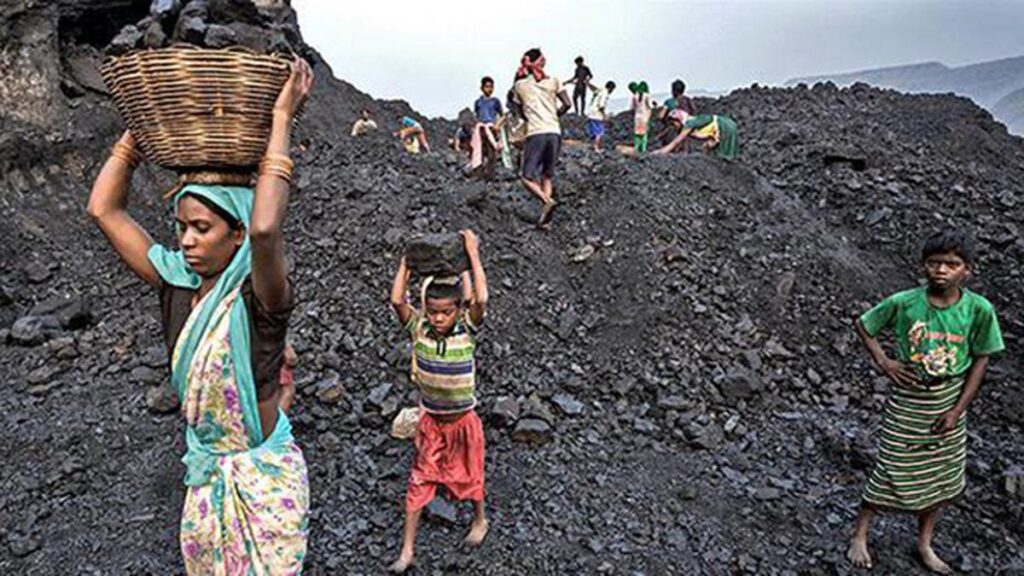
SECL's Historic ₹7,040 Crore Agreement with TMC Mineral Resources: Pioneering Paste Filling Technology in Indian Coal Mining | Industry Innovation
SECL’s Historic ₹7,040 Crore Agreement with TMC Mineral Resources: Pioneering Paste Filling Technology in Indian Coal Mining
South Eastern Coalfields Limited (SECL) becomes the first coal PSU in India to adopt innovative paste filling technology for underground mining operations
Table of Contents
- Groundbreaking Agreement: SECL and TMC Mineral Resources Partnership
- Understanding Paste Filling Technology: Innovation in Underground Mining
- Singhali Underground Mine Project: Implementation Details
- Overcoming Land Constraints: Mining Without Surface Disruption
- Environmental and Community Benefits of Paste Filling Technology
- Future Implications: Revitalizing Underground Coal Mining in India
- Economic Impact: Investment and Production Projections
In a landmark development for India’s coal mining sector, South Eastern Coalfields Limited (SECL), a subsidiary of Coal India Limited, has signed a ₹7,040 crore agreement with TMC Mineral Resources to implement innovative paste filling technology for underground coal extraction. This pioneering initiative marks a significant technological leap forward, making SECL the first coal public sector undertaking in India to adopt this advanced mining method that eliminates the need for surface land acquisition while ensuring environmental protection and structural stability.
Groundbreaking Agreement: SECL and TMC Mineral Resources Partnership
The historic agreement between SECL and TMC Mineral Resources Pvt Ltd represents a ₹7,040 crore investment into modernizing India’s coal mining infrastructure with cutting-edge technology. This partnership aims to revolutionize underground mining practices by implementing paste filling techniques at the Singhali underground coal mine in SECL’s Korba area, enabling large-scale production without surface disruption.
This collaboration positions SECL at the forefront of mining innovation in India’s public sector, demonstrating Coal India’s commitment to embracing sustainable and technologically advanced extraction methods. The agreement, announced on Friday, establishes a 25-year operational framework expected to yield approximately 8.4 million tonnes of coal over its lifetime, significantly extending the productive capacity of the Singhali mine.
Key Agreement Highlights
- Investment Value: ₹7,040 crore (approximately $840 million)
- Partnership Entities: South Eastern Coalfields Limited and TMC Mineral Resources
- Project Location: Singhali underground mine, Korba area, Chhattisgarh
- Production Target: 8.4 million tonnes over 25 years
- Technology Implementation: First paste filling technology deployment by an Indian coal PSU
Understanding Paste Filling Technology: Innovation in Underground Mining
Paste filling technology represents a significant advancement in underground mining methodology, offering solutions to long-standing challenges in the sector. This modern approach eliminates one of the primary obstacles in traditional mining operations – the need to acquire surface land rights, which often leads to displacement, environmental degradation, and community conflicts.
The technology works through a sophisticated process where, after coal extraction, the resulting voids are systematically filled with a specially engineered paste compound. This paste is created by combining fly ash (a byproduct from thermal power plants), crushed overburden material from opencast mines, cement, water, and specialized binding chemicals that create a stable structural fill.
| Paste Fill Component | Source/Purpose | Environmental Benefit |
|---|---|---|
| Fly Ash | Byproduct from thermal power plants | Repurposes industrial waste material |
| Crushed Overburden | Waste rock from opencast mines | Reduces surface waste dumps |
| Cement | Binding agent for structural integrity | Ensures long-term stability |
| Water | Required for paste consistency | Controlled usage minimizes water footprint |
| Binding Chemicals | Enhance strength and durability | Prevents subsidence and ground movement |
When properly implemented, paste filling technology prevents land subsidence – a common issue in underground mining that can damage surface infrastructure and natural landscapes. The technique ensures the structural stability of the mine while allowing for efficient resource extraction, representing a win-win solution for economic development and environmental protection.
Singhali Underground Mine Project: Implementation Details
The Singhali underground coal mine, located in SECL’s Korba area, will serve as the pioneering site for implementing paste filling technology in India’s coal public sector. Originally approved in 1989 with a modest production capacity of 0.24 million tonnes per year, the mine commenced operations in 1993 using conventional methods. The implementation of paste filling technology aims to revitalize and significantly expand operations at this historically important site.
Currently, the Singhali mine holds approximately 8.45 million tonnes of extractable reserves of non-coking coal, representing a valuable energy resource for the nation. The mine was previously developed using the Bord and Pillar method, employing load haul dumpers and universal drilling machines for underground operations – standard technologies that have limitations in densely populated or infrastructure-rich areas.
Singhali Mine Evolution
The transformation of the Singhali underground mine represents a case study in mining modernization:
- 1989: Initial approval with 0.24 million tonnes annual production capacity
- 1993: Commencement of operations using Bord and Pillar method
- Current Status: 8.45 million tonnes of extractable non-coking coal reserves
- Previous Constraints: Surface infrastructure limiting extraction capabilities
- Future Projection: 8.4 million tonnes production over 25 years using paste filling technology
The adoption of paste filling technology at Singhali will transition the mine from its traditional approach to a more sophisticated operation capable of extracting coal from areas that were previously inaccessible due to surface constraints. This represents not just a technical upgrade but a fundamental rethinking of how underground mining can coexist with surface development.
Overcoming Land Constraints: Mining Without Surface Disruption
One of the most significant challenges facing the Singhali underground mine has been the densely occupied surface area above its coal reserves. The region features villages, high-tension electricity transmission lines, and a public works department road – critical infrastructure that renders traditional caving methods unfeasible due to safety concerns and environmental risks.
Traditional underground mining methods often lead to surface subsidence as the earth above the extracted coal settles, potentially damaging or destroying any structures on the surface. This limitation has historically constrained mining operations in areas with significant surface development, effectively rendering valuable mineral resources inaccessible.
Surface Constraints at Singhali Mine
The complex surface environment above the Singhali mine includes:
- Established villages with residential populations
- Critical high-tension electricity transmission infrastructure
- Public Works Department road network with regular traffic
- Other public and private infrastructure developments
- Limited availability of alternative land for community relocation
The implementation of paste filling technology directly addresses these constraints by allowing mining activities to proceed without disturbing the surface infrastructure. By systematically filling the voids created during coal extraction, the method prevents the surface subsidence that would otherwise occur, maintaining the structural integrity of the ground above and protecting all surface assets.
This innovation effectively unlocks coal reserves that were previously considered unmineable due to surface constraints, representing a significant advancement in resource utilization without community displacement or infrastructure disruption.
Environmental and Community Benefits of Paste Filling Technology
Beyond its technical and operational advantages, paste filling technology offers substantial environmental and community benefits that align with modern sustainability objectives. The method represents a more environmentally conscious approach to resource extraction that minimizes the ecological footprint of mining operations while respecting community interests.
From an environmental perspective, paste filling technology delivers multiple benefits. It eliminates the need for surface land acquisition and clearing, preserving natural habitats and ecosystems. The method also repurposes industrial byproducts like fly ash, which would otherwise require separate disposal solutions, creating a circular economy approach within the industrial sector.
Environmental and Social Benefits
The implementation of paste filling technology at the Singhali mine delivers numerous advantages:
- Habitat Preservation: No surface land clearing required for mining operations
- Waste Reduction: Utilization of industrial byproducts (fly ash, overburden) as fill material
- Community Stability: No displacement of villages or residential populations
- Infrastructure Protection: Preservation of roads, power lines, and public facilities
- Reduced Surface Disturbance: Minimal visual impact and land transformation
- Groundwater Protection: Lower risk of aquifer disruption compared to traditional methods
For communities, the most significant benefit is stability – both physical and social. Villages above the mining area can continue their existence without relocation, preserving social bonds, cultural heritage, and economic activities. Essential infrastructure remains functional, ensuring continuity of services and transportation networks that support the broader regional economy.
This alignment of economic development with environmental protection and community welfare represents a model for responsible resource extraction that may influence future mining projects throughout India and beyond.
Future Implications: Revitalizing Underground Coal Mining in India
The successful implementation of paste filling technology at the Singhali mine has far-reaching implications for India’s coal mining sector. SECL’s pioneering initiative could pave the way for resuming operations in numerous other underground mines across the country where similar land constraints have rendered traditional mining methods unfeasible.
India has many underground coal mines that were either closed or operating below capacity due to surface infrastructure constraints, representing a significant untapped resource potential. The adoption of paste filling technology offers a pathway to activate these dormant assets, potentially increasing domestic coal production without expanding the land footprint of mining operations.
Potential Wider Implementation
The Singhali project could serve as a prototype for similar applications across India’s coal sector:
- Revival of dormant underground mines in populated regions
- Extension of operations in mines reaching conventional extraction limits
- Access to coal reserves beneath protected or developed areas
- Technology transfer to other mineral mining operations facing similar constraints
- Development of domestic expertise in advanced mining technologies
Beyond the immediate operational benefits, this technological advancement may help shift India’s coal mining paradigm from a predominant focus on opencast methods toward more underground operations. Such a shift could significantly reduce the environmental footprint of coal mining while still meeting energy needs during the country’s transition toward renewable sources.
Additionally, the development of expertise in paste filling technology creates opportunities for India to become a knowledge exporter in mining innovation, potentially offering technical consulting and services to other coal-producing nations facing similar challenges.
Economic Impact: Investment and Production Projections
The ₹7,040 crore investment in implementing paste filling technology at the Singhali mine represents a significant economic commitment to mining innovation. This substantial capital allocation reflects confidence in both the technology’s efficacy and the long-term viability of advanced underground coal mining in India.
Over its 25-year operational timeline, the project is expected to produce approximately 8.4 million tonnes of coal, representing an average annual production of about 336,000 tonnes – a significant increase from the mine’s original design capacity of 240,000 tonnes per year. This production boost will contribute to India’s domestic energy security while demonstrating the economic viability of technologically advanced underground mining.
| Economic Parameter | Value/Projection | Impact |
|---|---|---|
| Total Investment | ₹7,040 crore ($840 million) | Major capital infusion into mining technology sector |
| Project Duration | 25 years | Long-term operational stability and planning horizon |
| Total Production Target | 8.4 million tonnes | Significant contribution to domestic coal supply |
| Average Annual Production | 336,000 tonnes | 40% increase over original mine capacity |
| Technology Transfer Value | Pioneering implementation | Creation of domestic expertise in advanced mining |
Beyond direct production value, the economic benefits include employment generation, both during the technology implementation phase and throughout the extended operational life of the mine. The project will require skilled workers familiar with advanced mining techniques, potentially creating opportunities for workforce development and technical education in the region.
The successful implementation of paste filling technology at Singhali could also attract additional investment into India’s mining sector, particularly for projects facing similar challenges with surface constraints. This could potentially unlock substantial additional coal reserves that were previously considered uneconomical to extract, enhancing the nation’s resource security during its energy transition period.
As South Eastern Coalfields Limited pioneers this technological advancement in Indian coal mining, the Singhali project stands as a testament to how innovation can reconcile the seemingly competing demands of resource extraction, environmental protection, and community welfare. By enabling mining without surface disruption, paste filling technology offers a sustainable path forward for India’s coal sector as it balances energy security needs with broader sustainability goals.






